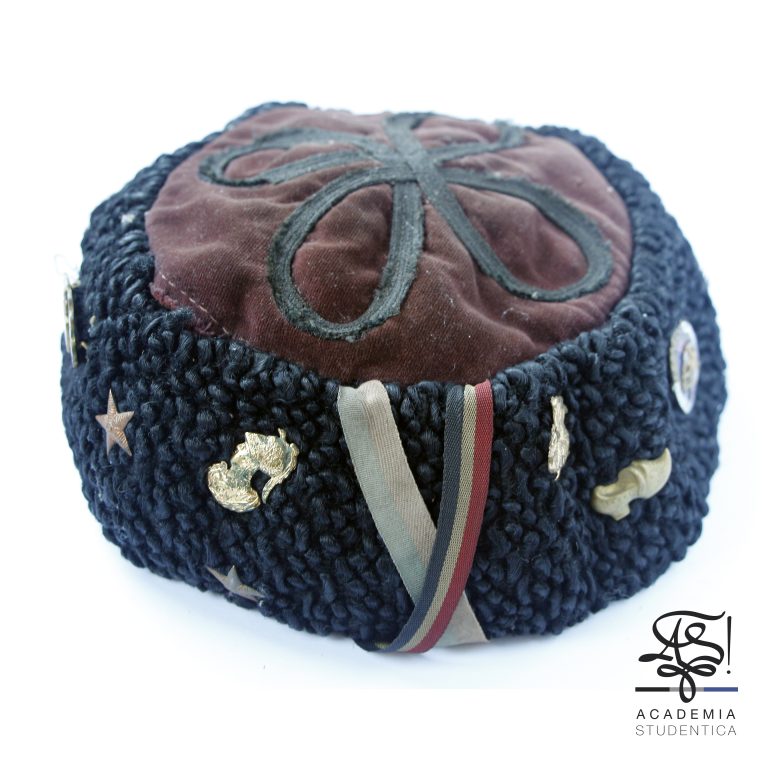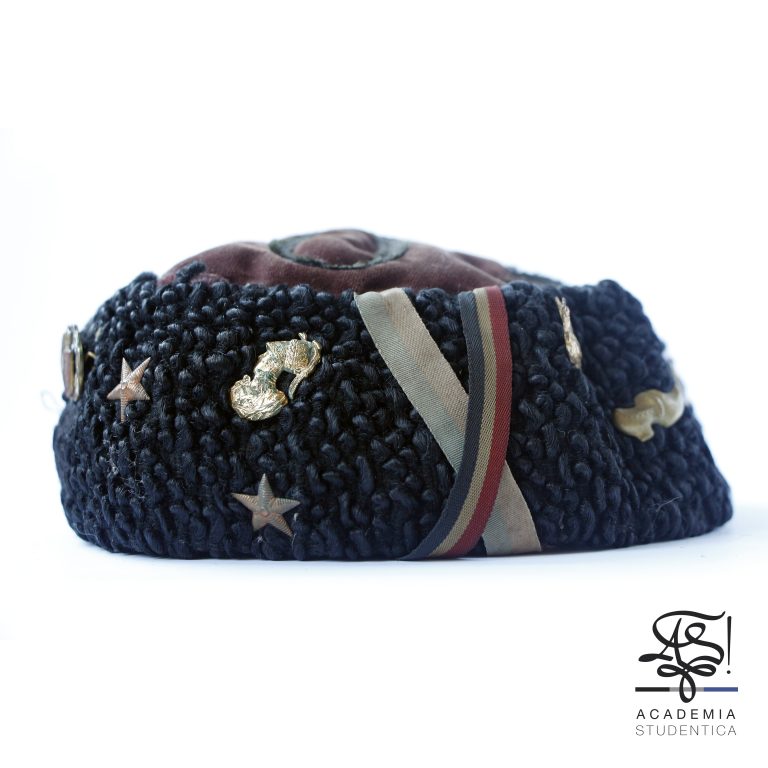Calotte, Catholic University of Leuven, Belgium, Leuven, 1925-1935.
Coll.: Cap’n
The calotte is the characteristic cap of French-speaking Catholic university students in Belgium. It is usually worn by students of Catholic universities.
The calotte is inspired by the cap of the papal zouaves in the 1860s. It is a cylindrical toque with a velvet cap and a crown in astrakhan.
The cap is wine coloured in Leuven, Louvain-la-Neuve, Brussels and Namur, but also in Fleurus, Tournai…, white in Ghent and green (emerald) in Liège. The original colour (bordeaux) is directly inspired by the colour of the cap of the papal zouaves. On the front of the crown there are crossed bands consisting of a ribbon in the national colours (black, yellow, red, or in heraldic sable on or on gules) running from top left (in front of the wearer) to bottom right, and a ribbon in the colours of the university where the cap was obtained. These are basically the colours of the city where the university is located. For the Université catholique de Louvain (UCLouvain) and the Katholieke Universiteit Leuven (KU Leuven) this is blue and white (azure on argent). A pin can be applied at the intersection of these two stripes. The students of UCLouvain and KU Leuven wear a papal stripe (yellow and white, to be read in heraldry: or and argent) as a reminder that the university was recognised as Catholic by a papal bull in 1425. The colours Gold and Silver symbolise the Pope’s two powers: Religion and Politics. They are also two metals that do not mix, just like the papal powers. The students of Namur wear a golden crown, this does not mean fidelity to the monarchy, nor does it remind them that the “Facultés Universitaires Notre-Dame de la Paix” were created by royal decree. It was a former president of the Liège region who liked it and caused a fashion trend. Since then, the students have kept it.
Calotte, Université Catholique de Louvain, Belgique, Louvain, 1925-1935.
Coll.: Cap’n
La calotte est le couvre-chef caractéristique des étudiants universitaires francophones de confession catholique en Belgique. Elle est surtout portée par les étudiants des universités catholiques
Librement inspirée du talpack de grande tenue adopté par le corps des zouaves pontificaux dans les années 1860, la calotte est une toque cylindrique, dont le calot est de velours et la couronne d’astrakan.
La calotte est de couleur lie-de-vin à Louvain, Louvain-la-Neuve, Bruxelles et Namur ainsi qu’à Fleurus, Tournai…, blanc à Gand et vert (émeraude) à Liège. La couleur originale (lie-de-vin) est directement inspirée de la couleur du calot de la toque de drap rouge des zouaves pontificaux. Sur l’avant de la couronne, on trouve un croisillon composé d’une bande, l’emblème, aux couleurs nationales (noir, jaune, rouge, soit en héraldique sable sur or sur gueule) allant d’en haut à gauche (pour le porteur) jusqu’en bas à droite, et d’une bande aux couleurs de l’université où la calotte a été obtenue, la banière. Il s’agit en principe des couleurs de la ville où siège l’université. Pour l’Université catholique de Louvain (UCLouvain) et la Katholieke Universiteit Leuven (KU Leuven), il s’agit toutefois du bleu et du blanc (azur sur argent). À l’intersection de ces deux bandes peut se trouver un insigne complémentaire. Les étudiants l’UCLouvain et la KU Leuven portent une bande papale (jaune et blanc, à lire en héraldique : or et argent) rappelant que l’université en 1425 fut reconnue comme catholique par une bulle du papale . Les couleurs Or et Argent symbolisent les deux pouvoirs du pape : Religion et Politique. Ce sont également deux métaux qui ne se mélangent pas comme les pouvoirs du pape. Les étudiants de Namur portent une couronne dorée, ceci ne signifie pas une fidélité à la monarchie, ni que la couronne rappelle que les Facultés Universitaires Notre-Dame de la Paix ont été fondées par un arrêté royal. C’est un ancien président de la Liégeoise qui trouvait cela beau et provoqua un effet de mode. Depuis, les étudiants l’ont conservé.
Calotte, Katholieke Universiteit Leuven, België, Leuven, 1925-1935.
Coll.: Cap’n
De calotte is het karakteristieke hoofddeksel van Franstalige katholieke universiteitsstudenten in België. Ze wordt meestal gedragen door studenten van katholieke universiteiten.
De calotte is geïnspireerd op de pet van de pauselijke zouaven in de jaren 1860. Het is een cilindervormige toque met een fluwelen kap en een kroon in astrakan.
De pet is wijnkleurig in Leuven, Louvain-la-Neuve, Brussel en Namen, maar ook in Fleurus, Doornik…, wit in Gent en groen (smaragd) in Luik. De oorspronkelijke kleur (bordeaux) is direct geïnspireerd op de kleur van de pet van de pauselijke zouaven. Op de voorzijde van de kroon bevinden zich gekruiste banden bestaande uit een lint, in de nationale kleuren (zwart, geel, rood, of in heraldisch sabel op or op keel) dat van linksboven (voor de drager) naar rechtsonder loopt, en een lintin de kleuren van de universiteit waar de pet is verkregen. Dit zijn in principe de kleuren van de stad waar de universiteit gevestigd is. Voor de Université catholique de Louvain (UCLouvain) en de Katholieke Universiteit Leuven (KU Leuven) is dit blauw en wit (azuur op argent). Op het kruispunt van deze twee strepen kan een pin aangebracht worden. De studenten van de UCLouvain en de KU Leuven dragen een pauselijke streep (geel en wit, te lezen in de heraldiek: or en argent) als herinnering dat de universiteit in 1425 door een pauselijke bul als katholiek werd erkend. De kleuren Goud en Zilver symboliseren de twee machten van de paus: Religie en Politiek. Het zijn ook twee metalen die zich niet mengen, net zoals de pauselijke machten. De studenten van Namen dragen een gouden kroon, dit betekent geen trouw aan de monarchie, noch herinnert de kroon eraan dat de “Facultés Universitaires Notre-Dame de la Paix” bij koninklijk besluit werden opgericht. Het was een voormalige president van de Luikse regio die het mooi vond en een modetrend veroorzaakte. Sindsdien hebben de studenten het bewaard.






